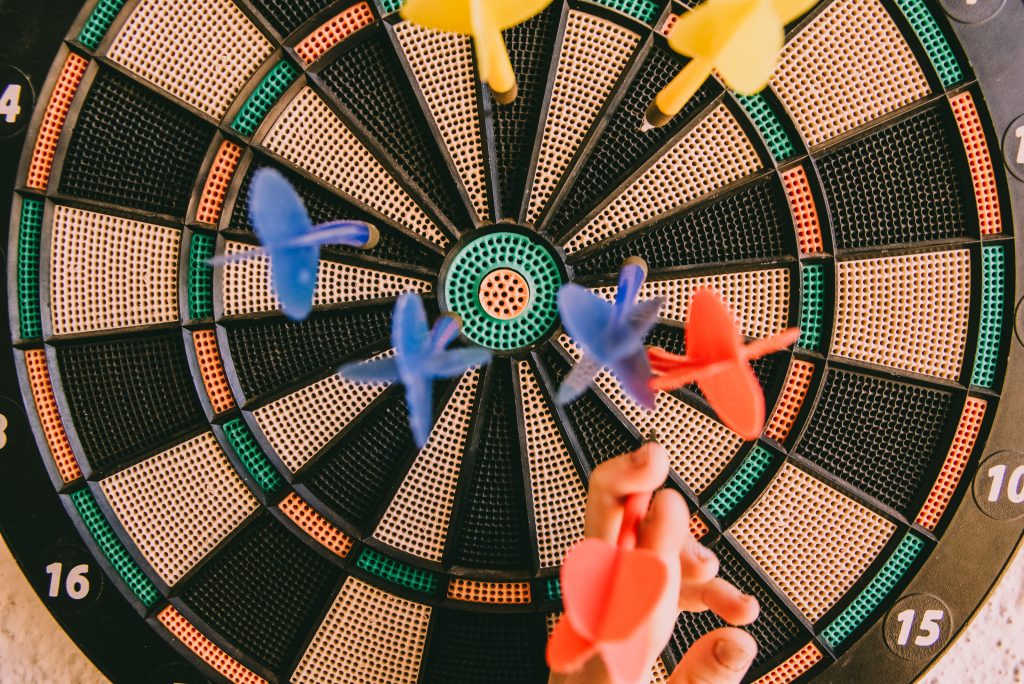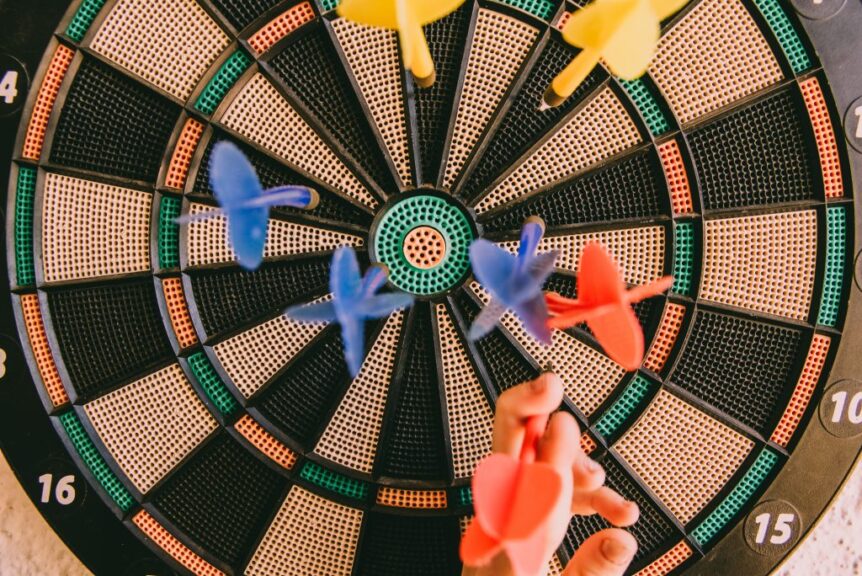Are stock market returns really just “monkey business”?
In 1973, Princeton economist Burton Malkiel made a bold claim in his new book about the stock market, A Random Walk Down Wall Street:
A blindfolded monkey throwing darts at a newspaper’s financial pages could select a portfolio that would do just as well as one carefully selected by experts.
Burton Malkiel
It was a bold and controversial claim. Few people really believed Malkiel’s thesis. Then the games began… the stock-picking games!

Beginning in 1988, The Wall Street Journal ran a contest to determine if stock-picking was really just “monkey business.” They pitted the experts against a randomly selected portfolio of stocks. Instead of monkeys, they let WSJ staffers throw darts at a list of public companies every 6 months. (This simulated the picks of a “blindfolded monkey” without the liability risk of a live animal.)
The experts squeaked by in the initial battle, but the darts proved themselves a worthy competitor over the years, winning almost as often. As the contest evolved, six WSJ readers were also selected to compete. Like the professionals, they got to choose their stocks.
Much fun was had while Malkiel’s point was tested. Over the years, there was surprisingly little difference in win rates between the portfolios chosen with darts, selected by professionals, or picked by the readers. In the final contest in April of 2013, the darts trumped the readers (and the experts) with impressive gains of 17.4%.
Today, the WSJ Investment Dartboard Contest has been retired. The journal cited a desire to dedicate resources elsewhere (although one wonders if the experts were just tired of being embarrassed by lackluster performance). However, Malkiel’s hypothesis inspired many other stock-picking contests with surprising results!
Three Monkeys (Blindfold Optional) and a Cat
Some enterprising analysts employed real monkeys for their random picks. In 1999, a chimpanzee named Raven threw ten darts at a board with 133 internet-related companies, creating the short-lived “MonkeyDex” index. One of her picks was up 95% by the week’s end. Ultimately, Raven outperformed more than 6000 money managers, and her portfolio earned a 213% return.
In 2010, a Russian circus chimp named Lusha picked a portfolio that beat 94% of Russia’s mutual funds. (This while maintaining her day job of riding a scooter.) According to The Daily Mail, she almost tripled her initial capital of 1 million rubles ($35,884). Pavel Trunin from Moscow’s Institute for the Economy in Transition acknowledged, “It shows that financial knowledge does not play a great role in giving forecasts to how the market will change.” (🡨Uncertain if the quote adds anything or not… keep or delete!)
The most famous simian money manager was Adam Monk, a Brazilian cinnamon-ringtail Cebus monkey who picked stocks for the Chicago Sun-Times. Mr. Monk simply circled his choices in the newspaper with a red pen without a single glance at P/E ratios or quarterly reports! Although now retired from stock picking, Adam Monk outperformed the indices for four years straight, from 2003 to 2006. Even in 2008, when most money managers lost upwards of 35%, Monk’s portfolio was only down by 14%.
However, primates aren’t the only leaders in the field of random stock picking. In 2013, The Observer, a British newspaper, organized a challenge between three teams. The first was a group of novice finance students, the second was comprised of a wealth manager, stockbroker, and fund manager, and the third team was a ginger tabby named Orlando. The cat selected his winning stocks by tossing a toy mouse onto a grid of choices. By the year’s end, the students lost money, the pros gained 3.5%, and Orlando’s portfolio boasted a return of nearly 11%.
Why Money Managers Rarely Impress
How can picks by monkeys, cats, and random dart throws compete with and beat so many professional wealth managers? There are multiple reasons why people rarely get the results they aim for, whether money managers or retail investors.

First, let’s return to Malkiel’s theory: investors cannot consistently outperform the market because it is inherently irrational. The blips and dips in security prices caused by random world events like terrorist attacks, government scandals, and unjustified exuberance or pessimism create an environment you can’t predict or outsmart.
Those who try to time the market almost never get it right. Then there are “black swan” events such as the collapse of Enron, Lehman Brothers, and the mortgage bond market. Wins are ascribed to smart choices while losses are blamed on bad luck.
The old adage, “only invest what you can afford to lose,” comes to mind. While the stock market does trend upward over time, it is fundamentally unpredictable. You may think you’ve “won”—and for now, you have. But you could just as easily have lost.
Perhaps that’s why few professional money managers match the market returns of the benchmark index funds with any regularity. CNBC reported in March of 2022, “The S&P Indices versus Active (SPIVA) scorecard, which tracks the performance of actively managed funds… recently showed 79% of fund managers underperformed the S&P last year.”
A 2019 study of market indices versus active management reported even more dismal results. Over 10 years, 85% of large-cap mutual funds underperformed the S&P 500. After 15 years, 92% trailed the index.
Yes, about 8 out of 10, even 9 out of 10 money managers do worse than the S&P 500 market benchmark—a curious “accomplishment.”
Then there are the fees. In a HuffPost Business column, Mark Gangloff joked, “The great thing about letting a cat pick your stocks for you is the low fees.” While the contests did not consider expenses, in the real world, they matter. Fees and commissions effectively place a potentially significant drag on the growth of professionally managed funds and portfolios from which many retirement nest eggs never recover.
And higher fees do not equate to better returns. Hedge funds are known for the highest fees in the industry and, in recent years, dismal results. Some funds still command the “2 and 20” fee structure, which means they collect a 2% management fee PLUS 20% of yearly profits. And the performance? In the 10 years from 2011 to 2020, hedge funds earned less than one-quarter of the gains of the S&P 500, according to an analysis by computer scientist Harry Saunders.
Another factor in favor of the monkeys and cats is the removal of emotion from the process. They don’t chase returns with the fear of missing out or panic-sell when the market corrects. They don’t hang on to “prove themselves right” when their favorite stock has a terrible earnings report. Unfortunately, human investors, especially retail investors, do all of the above.
That’s a big reason it’s not just professional money managers who underperform the market. Individual “Main Street” investors are also losing their Wall Street bets—by substantial margins.
Individual Investors Rarely Earn “Market Returns.”
Remember the graphs your broker showed you, pointing out how stocks earn certain returns over time? Remember the “hockey stick” charts with compounding gains? Those results were hypothetical possibilities based on stock market indices—not real-world investor results!
Research from Dalbar’s annual Quantitative Analysis of Investor Behavior survey reveals the average individual investor has underperformed the S&P 500 by an average of 4.5% per year over the last 30 years. That’s a 6.2% versus 10.7% return. Depending on your contribution schedule, that could mean having TWICE as much money in retirement.

Fear, greed, and management fees contribute to some of this loss, but it’s not the whole story.
There are also financial reasons that don’t impact monkeys or darts. How many investors have sold when markets were down because of recessions that also caused layoffs or reduced work hours? Selling stocks after market losses ends up costing investors far more than most realize. Yet, many investors haven’t prepared another “bucket” of liquid capital from which they can draw when they need cash in a down market.
A “Random Walk” or Predictable Success?

Malkiel’s book, A Random Walk Down Wall Street, is still an investment classic. It has helped many investors understand the futility of predicting the market and the reasons why even “the experts” rarely outperform blindfolded monkeys with darts!
However, you might not be satisfied with random, unpredictable results. You might hope your portfolio DOESN’T mirror the performance of major indices when they are falling by 40, 50, or even 60 percent.
The S&P 500 took nearly 6 years to regain its 20O7 highs… 7 years adjusting for inflation. The 1973 and 2000 stock crashes both took nearly 8 years to get back to pre-crash levels. Are you willing to lose that kind of time and money?
If you prefer to sleep at night, we have strategies that will protect your principle—even if you want to be able to capitalize on future bull markets.
Reach out to us at go.surewealthway.com and let’s talk.
We’ll walk through verifiable numbers and explore how you can get the results you want without darts, blindfolds, or monkeys!

